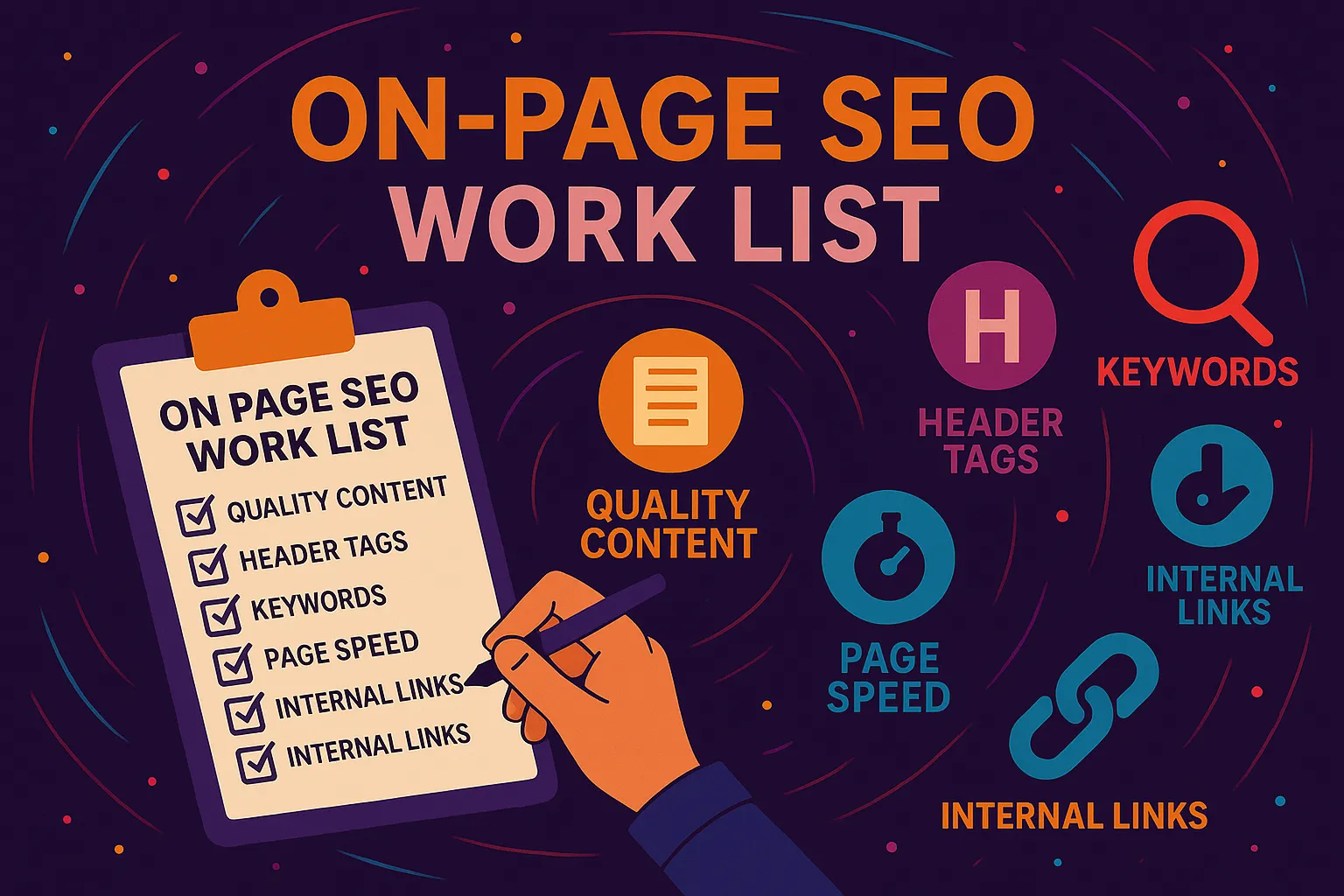What Is Technical SEO Work?
At its core, technical SEO work is the practice of optimizing the backend of a website so search engines can easily crawl, index, and rank its pages. Unlike on-page SEO, which is about content and keywords, or off-page SEO, which is about links and authority, technical SEO is all about the framework.
Think of it as the plumbing and wiring of your digital home— invisible to users but absolutely critical to everything else functioning properly. For over a decade, our team at Vibe Branding has helped businesses build SEO foundations that actually perform, because without strong tech SEO, even the best content is at risk of being invisible.
TL;DR (Too Long; Didn’t Read)
- Technical SEO work focuses on improving a website’s infrastructure for better search engine visibility.
- It’s different from content and link-building; it handles speed, crawlability, indexation, mobile usability, and structured data.
- Core topics include audits, error fixes, schema, Core Web Vitals, and internal linking.
- Tools like Google Search Console, Screaming Frog, and Ahrefs are key in this process.
- Our agency, Vibe Branding, uses 10 years of experience to deliver technical SEO work that moves the needle.
How Technical SEO Differs From On-Page and Off-Page SEO
One of the most common misunderstandings I run into is when clients think SEO is only about keywords or blogging. While that’s a big part of it, it’s only one piece of the puzzle.
Technical SEO work is about the backend: server speed, site architecture, redirects, indexing rules, mobile optimization—all the stuff that helps your site load quickly, get found by search engines, and rank. On-page SEO handles things like headers, meta descriptions, and internal keyword targeting.
Off-page SEO focuses on backlinks, authority, and PR strategies. But none of that will matter if Google can’t access your site properly or your load time is a sluggish 6 seconds.
I often explain to clients that technical SEO is like building the roads and street signs for a city. If Google is the car, it needs well-paved roads and clear directions to navigate your content.
Otherwise, it just drives right past.

Why Technical SEO Is Essential for Visibility and Speed
The performance of your website matters more today than ever. And technical SEO work plays a massive role in that.
Google’s algorithm gives real weight to things like page speed, mobile usability, and secure browsing (HTTPS). If your site loads slowly or gives users a poor mobile experience, it sends bad signals to Google—and you could drop in rankings as a result.
From our experience at Vibe Branding, we’ve seen clients increase traffic by 30-40% simply by fixing crawl errors, eliminating broken links, and streamlining site architecture. It’s not just about being indexed—it’s about being presented as a quality source of information.
If Google finds your site technically sound, you’re more likely to appear in the top results, period.
Core Components of Technical SEO Work
Now that we understand the “why,” let’s dive into the “what.” There are five major parts of technical SEO work we implement across all client projects:
- Crawlability: Making sure search engine bots can access and travel through your site.
- Indexation: Ensuring that the right pages are indexed and duplicate or junk pages are excluded.
- Speed: Page speed matters for both SEO and user satisfaction. Optimizing server response times, compressing images, and using CDNs all help.
- Mobile-friendliness: Google uses mobile-first indexing, so your mobile experience must be flawless.
- Structured Data: Using schema markup helps search engines better understand your content and can increase CTR through rich results.
Component | Benefit | Tool Used |
Crawlability | Ensures bots can access all content | Screaming Frog, GSC |
Indexation | Only valuable pages get indexed | Google Search Console |
Speed | Faster load = better rankings | PageSpeed Insights |
Mobile-Friendly | Supports mobile-first indexing | GSC, Mobile-Friendly Test |
Structured Data | Unlocks rich snippets | Schema.org, Ahrefs |
How to Perform a Technical SEO Audit
When we onboard a new client at Vibe Branding, one of the first things we do is run a technical SEO audit. This process lets us see everything that could be holding the site back—from crawl errors to redirect issues.
Our go-to tools include Screaming Frog for deep site crawls, Google Search Console for real-time indexing insights, and Ahrefs for broken links and overall SEO health. We look for signs of inefficient internal linking, orphaned pages (pages with no internal links), and duplicate content.
Each of these can hurt your visibility if left unchecked. We also audit for sitemap issues and make sure robots.txt files aren’t unintentionally blocking valuable content.
A proper audit gives us the blueprint to take action. Without one, it’s like driving blind.

Technical SEO Tools That Make the Job Easier
You can’t do technical SEO work properly without the right tools. Over the years, we’ve narrowed down our toolkit to a few essentials:
Google Search Console is our dashboard for understanding how Google views the site. Screaming Frog lets us perform a complete crawl of a site’s structure.
Sitebulb helps with visualization and prioritization—especially helpful for larger sites. Ahrefs gives us deep link insights and schema tracking.
PageSpeed Insights is our go-to for understanding how real users experience load times. Each of these tools serves a purpose.
We often layer insights from all of them to create a comprehensive action plan. No single tool covers everything, but together they create a complete picture.
Common Technical SEO Problems (And How We Fix Them)
After auditing over 300 sites in the last decade, we’ve seen the same technical SEO work problems pop up again and again. Here are the big ones we solve regularly:
- Broken links (404 errors): These not only hurt UX but waste valuable crawl budget.
- Duplicate content: This confuses search engines.
- Redirect chains: Too many redirects slow down page load and dilute link equity.
- Orphan pages: Pages with no links pointing to them often go unseen.
- Improper indexing rules: We clean up the robots.txt and sitemap to ensure only the right content is crawled and indexed.
In many cases, these fixes alone can improve rankings without touching content. That’s the power of back-end optimization.
Understanding Core Web Vitals and User Experience
Google made it clear: page experience matters. With Core Web Vitals, they measure how fast your site loads, how stable it is while loading, and how quickly users can interact with it.
These metrics include Largest Contentful Paint (LCP), Cumulative Layout Shift (CLS), and First Input Delay (FID). Each one tells us something important about how users are experiencing your website.
If your site takes forever to show the main content (LCP), users might bounce before they even see what you offer. If your page jumps around while loading (CLS), it’s frustrating.
And if users try to click but the page lags (FID), that sends a bad signal. That’s why part of our technical SEO work includes optimizing code, deferring unnecessary scripts, compressing assets, and improving server response times.

The Role of Schema Markup in SEO Success
We love schema markup because it gives us superpowers. Not in the comic-book sense, but in the Google-snippet sense.
Schema is a form of structured data that helps search engines understand what your content is about. Whether you’re listing products, events, recipes, or services, schema allows you to show up with rich results—those attractive search listings that display reviews, pricing, and more.
At Vibe Branding, we implement schema using either JSON-LD or plugins depending on the platform. We test everything with Google’s Rich Results Test and make sure we’re eligible for maximum visibility.
Over the years, we’ve seen rich snippets lift CTR by as much as 25%. This is one of those quiet SEO wins that makes a measurable difference over time.
Why Technical SEO Requires Ongoing Maintenance
Technical SEO isn’t a one-and-done project. Websites evolve—pages get added, content gets removed, platforms get updated, and tools change.
That’s why ongoing audits are part of our standard operating procedure. We schedule quarterly reviews for all our long-term clients. We also implement monitoring alerts.
If Google Search Console flags a sudden drop in indexed pages or PageSpeed Insights shows a slowdown, we investigate immediately. Staying proactive rather than reactive saves money and preserves rankings.
This consistency in our technical SEO work is what allows our clients to maintain their search presence without surprises.
Should You Handle Technical SEO In-House or Outsource It?
Many businesses ask us if they should hire someone internally or bring in an agency. The honest answer?
It depends on the size of your site, your resources, and your long-term goals. For smaller websites with minimal complexity, a trained internal team member might be enough.
But for mid-sized to enterprise sites—especially those relying on SEO traffic for leads or sales—you need depth of experience and the right toolset. Our agency, Vibe Branding, has specialized in this for over 10 years.
We know how to align business goals with technical execution. We bring speed, precision, and a battle-tested process that in-house teams often don’t have the time or tools to replicate.
Whether it’s a quick audit or an ongoing strategy, outsourcing your technical SEO work can help you stay competitive without burning out your dev team.
The Business Impact of Doing Technical SEO Right
When technical SEO is done well, everything else works better. Your content ranks faster.
Your bounce rates go down. Your traffic and leads go up.
We’ve worked with ecommerce clients who saw a 60% increase in conversions simply by fixing mobile usability and reducing load times by 3 seconds. Technical SEO supports ROI in ways that aren’t always visible but absolutely critical.
Think of it like tuning an engine—you may not see it under the hood, but it’s what powers everything forward. That’s why we treat technical SEO work as foundational.
It’s not just a service. It’s part of our core philosophy at Vibe Branding.





